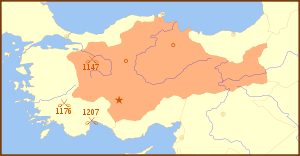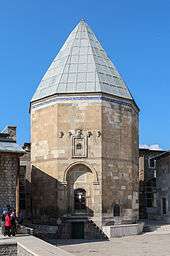Kilij Arslan II
 Seljuk Sultanate of Rûm, 1190 | |||||
| Seljuq sultans of Rum | |||||
|---|---|---|---|---|---|
| Reign | 1156-1192 | ||||
| Predecessor | Mesud I | ||||
| Successor | Kaykhusraw I | ||||
| Died | 1192 | ||||
| |||||
Kilij Arslan II (Old Anatolian Turkish: قِلِج اَرسلان دوم) or ʿIzz ad-Dīn Qilij Arslān bin Masʿūd (Persian: عز الدین قلج ارسلان بن مسعود) (Modern Turkish Kılıç Arslan, meaning "Sword Lion") was a Seljuk Sultan of Rûm from 1156 until his death in 1192.
Reign
As Arnold of Lübeck reports in his Chronica Slavorum, he was present at the meeting of Henry the Lion with Kilij-Arslan during the former's pilgrimage to Jerusalem in 1172. When they met near Tarsus, the sultan embraced and kissed the German duke, reminding him that they were blood cousins ('amplexans et deosculans eum, dicens, eum consanguineum suum esse'). When the duke asked for details of this relationship, Kilij Arslan informed him that 'a noble lady from the land of Germans married a king of Russia who had a daughter by her; this daughter's daughter arrived to our land, and I descend from her.' The Russian king in question is assumed to have been Svyatoslav II.
In 1159, Kilij Arslan attacked Byzantine emperor Manuel I Comnenus as he marched past Iconium (Konya, capital of Rüm), as Manuel returned from negotiating with Nur ad-Din Zengi in Syria. In 1161 Manuel's nephew John Contostephanus defeated Kilij Arslan, and the sultan travelled to Constantinople in a show of submission. In 1173 Kilij Arslan, now at peace with the Byzantines, allied with Nur ad-Din against Mosul.

The peace treaty with the Byzantines lasted until 1175, when Kilij Arslan refused to hand over to Manuel the territory conquered from the Danishmends, although both sides had for some time been building up their fortifications and armies in preparation for a renewed war. Kilij Arslan tried to negotiate, but Manuel invaded the sultanate in 1176, intending to capture Iconium itself. Kilij Arslan was able to defeat Emperor Manuel I Komnenos's army at the Battle of Myriokephalon,[1] the Sultan forced the emperor to negotiate a fragile peace.
In 1179 Kilij Arslan captured and held to ransom Henry I, the renowned count of Champagne, who was returning overland from a visit to Jerusalem. The ransom was paid by the Byzantine Emperor and Henry was released, but died soon afterwards.
In 1180 the sultan took advantage of the instability in the Byzantine Empire after Manuel's death to secure most of the southern coast of Anatolia, and sent his vizier Ikhtiyar al-Din to conclude an alliance with Saladin, Nur ad-Din's successor, that same year. Then in 1182, he succeeded in capturing the city of Cotyaeum from the Byzantines. In 1185 he made peace with Emperor Isaac II Angelus, but the next year he transferred power to his nine sons, who immediately fought each other for control. Despite Kilij Arslan's alliance with Saladin he was unable to stop the armies of the Third Crusade, but the remnants of the German army were in any case destroyed by the Turks after the death of Frederick Barbarossa.
During the late 12th century, at the behest of Kilij Arslan II, the Seljuq palace Alâeddin Kosku was built in Konya.[2]
Kilij Arslan died in 1192, after promising Kaykhusraw I the succession.[3] Kaykhusraw I's brothers continued to fight for control of the other parts of the sultanate.
References
- ↑ Rouben Paul Adalian, Historical Dictionary of Armenia, (Scarecrow Press, Inc., 2010), 514.
- ↑ Scott Redford, Thirteenth-Century Rum Seljuq Palaces and Palace Imagery, Ars Orientalis, Vol. 23, 1993:220-221.
- ↑ The Turks in Iran and Anatolia before the Mongol Invasions, Claude Cahen, A History of the Crusades, Vol.2, Ed. Robert Lee Wolff and Harry W. Hazard, (The University of Wisconsin Press, 1969), 680-681.
| Preceded by Mesud I |
Sultan of Rûm 1156–1192 |
Succeeded by Kaykhusraw I |